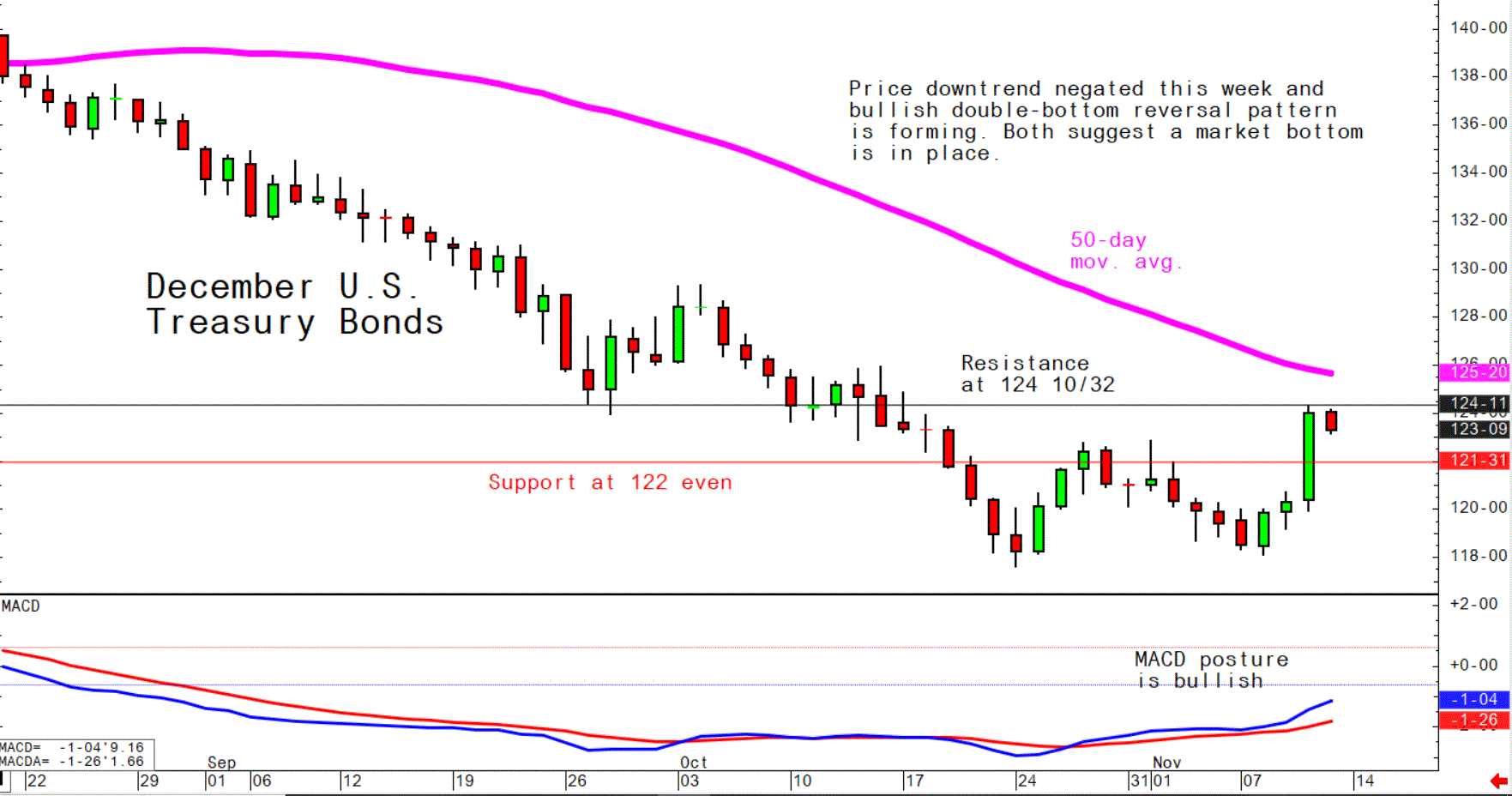Midterm Elections: Bewildering and a Slog as Many Vote Results Awaited in Arizona, Calif., Nevada

Is peak inflation in sight?

|
In Today’s Digital Newspaper |
What ag bankers told us. We attended and participated at the American Ag Bankers Assn. annual conference. Bankers told us that the ag sector overall will be in good shape for 2023, largely because of relatively firm prices this past year. But most are concerned about 2024 as some income transfer payments end and input prices likely will still impact operations. Operating loans are currently at 7.5% to 8% and if the Fed Funds rate goes to around 5%, operating loans will rise to 10.5% to 11% we were told. This is one of the reasons USDA’s FSA loan programs will see increased use as those rates are much lower and will give farmers cash flow while awaiting marketing opportunities. USDA: Farm Operating- Direct 4.375%; Farm Operating – Microloan 4.375% (link).
The U.S. dollar index continues its drop and hit a 2.5-month low overnight, while the benchmark 10-year U.S. Treasury note yield is 3.811% after trading above 4.0% earlier this week. The U.S. Treasury cash markets are closed today for the Veteran’s Day holiday.
U.S. equities on Thursday surged in large part due to the October Consumer Price Index. One analyst writes: “If we look at CPI excluding shelter costs (housing and rent related costs) core CPI declined by 0.1%.”
According to the CME's FedWatch Tool, markets are now pricing in an 80.6% probability of a 50-basis-point hike rather than a 75-point one at the central bank's policy meeting next month.
China made more than 20 changes to Covid policies over-night, all of which relaxed Covid rules and further signaling a departure from zero-Covid.
Britain's economy shrank in the three months to September at the start of what is likely to be a lengthy recession, underscoring the challenge for finance minister Jeremy Hunt as he prepares to raise taxes and cut spending next week.
The Eurozone has forecast its inflation rate for 2022 at 8.5%, year-on-year, and at 6.1% in 2023.
As of Thursday night, Republicans have secured at least 211 House of Representatives seats, Edison Research projected, just seven shy of the 218 needed to seize control from Democrats. But 27 races are yet to be determined, including 16 of the most competitive based on a Reuters compilation of the leading nonpartisan forecasters. The Wall Street Journal reports that with Democrats claiming 192 seats so far, the GOP “remained on track” to take control of the House. More on the bewildering midterm elections in Politics & Elections section.
President Biden conceded that Democrats face “long odds to keep control” of the House. Biden, speaking to reporters Thursday evening as he left the White House for a series of overseas summits, said “it’s not impossible for Democrats to prevail in the House contest but unlikely.” Biden said, “It’s still alive. It’s still alive. But it’s like drawing an inside straight.”
Twitter's new owner Elon Musk raised the possibility of the social media platform going bankrupt, capping a chaotic day that included a warning from a U.S. privacy regulator and the exit of the company's trust and safety leader. In his first company-wide email, Musk warned that Twitter would not be able to "survive the upcoming economic downturn" if it fails to boost subscription revenue.
|
MARKET FOCUS |
Equities today: Global stock markets were mostly higher overnight. U.S. stock indexes are headed for higher openings. Chinese stocks surged Friday, after top officials in Beijing said they would try to minimize the economic impact from the country’s zero-Covid policy and promptly eased some of its quarantine restrictions. In Asia, Japan +3%. Hong Kong +7.7%. China +1.7%. India +2%. In Europe, at midday, London -0.4%. Paris +0.4%. Frankfurt +0.6%.
U.S. equities yesterday: The Dow shot up 1,201.43 points, 3.70%, at 33,715.37. The Nasdaq gained 760.97 points, 7.35%, at 11,114.15. The S&P 500 rose 207.80 points, 5.54%, at 3,956.37. The three indices each recorded their best day since 2020. All three major U.S. stock indexes are now heading for sharp weekly gains, with the Dow and S&P 500 adding 4.4% and 5.4%, respectively, while the Nasdaq outperformed by rising more than 7%.
Markets are pricing in a greater likelihood that the Federal Reserve will shift to a smaller 0.5-percentage-point interest-rate increase at its next meeting in December — and a somewhat lower peak rate for the current cycle of increases.
The dollar is continuing to unwind gains after the dollar index notched its biggest one-day drop since 2009. Near-term support at 108.33 was broken yesterday, which signals more dollar weakness ahead and shifted the medium-term outlook from decidedly bullish to more neutral. Analysts say the DXY needs to fall below the August lows of 105.09 for the longer-term uptrend to be declared over. But, says one analyst: “We're one hawkish comment from a Fed official away from a face-ripper rally in the dollar.”
The crypto sphere remains unsettled. Cryptocurrency prices are down after a rough week following crypto exchange FTX's fall from grace. Crypto lender BlockFi has halted withdrawals, citing FTX's travails.
U.S. government bond yields marked their steepest one-day declines in more than a decade Thursday after fresh data showed inflation fell more in October than Wall Street expected.
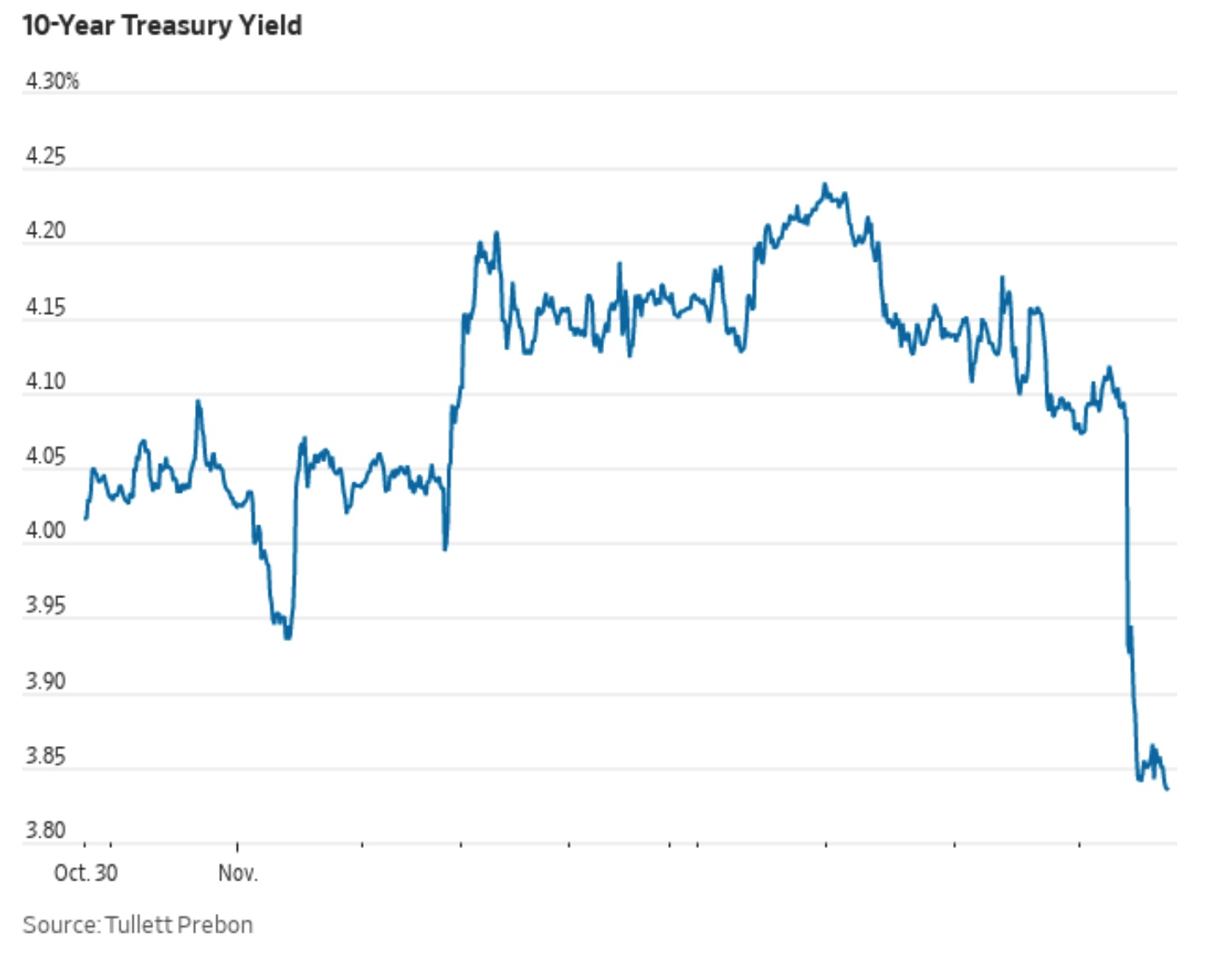
Americans grappling with high inflation are finally getting some relief at the grocery store. Prices overall have surged 12.4% through October versus a year ago, but analysts at the market research firm NielsenIQ say there are some deals to be had. In fresh produce, the average price for prepared mixed vegetables dropped 68% versus the same period last year. A lot of fresh seafood options are cheaper as well: striped bass fell 41.8% over the prior year while the cost of lobster is also down 7.2%. Some packaged baked goods such as assorted bagels fell 48%. Bakery sweet goods and cranberry sauce are also seeing declining prices just in time for the holidays. And in beverages, kombucha drinks have dropped 22.7%. Most consumers are also not buying in bulk, analysts say, as more shoppers are opting for smaller sizes to control their spending.
Importing nations face ballooning costs for staples from grains to vegetable oils, signaling that food insecurity is worsening. The global food import bill is set to climb to a record $1.94 trillion in 2022, some $128.6 billion more than predicted in June, as production costs soar and supply chains are disrupted, the United Nations’ Food and Agriculture Organization said. Many economically vulnerable countries are paying more while receiving less food, the agency warned. Link for more via Bloomberg.
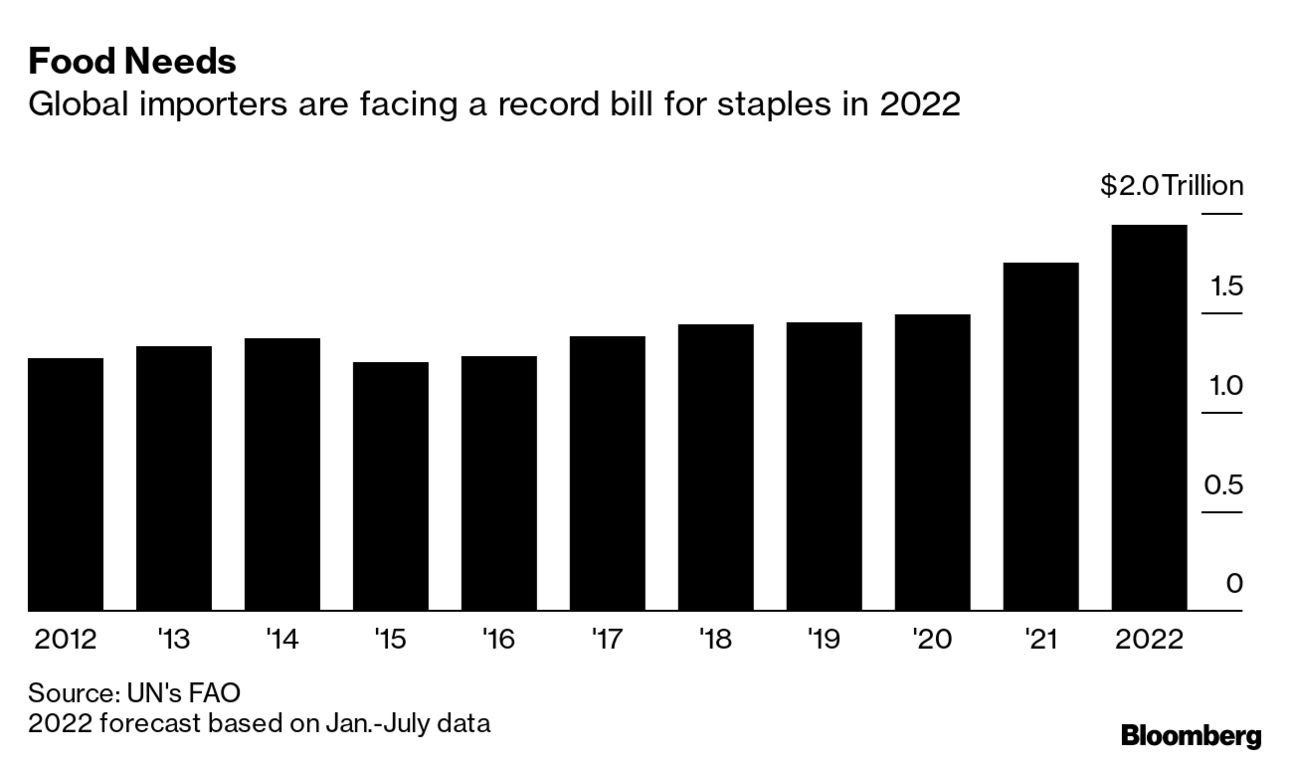
Agriculture markets yesterday:
- Corn: December corn fell 11 1/4 cents to $6.53 1/4, the lowest close since Aug. 25.
- Soy complex: January soybeans plunged 29 cents to $14.23, the contract’s lowest close since Oct. 31. December soymeal tumbled $13.50 to $404.10, a three-week closing low. December soyoil rose 55 points to 76.09 cents.
- Wheat: December SRW wheat fell 3 cents to $8.03 1/2, the contract’s lowest close since Sept. 1. December HRW wheat dropped 4 3/4 cents to $9.25 1/4. December spring wheat fell 6 3/4 cents to $9.31 1/2, the lowest close since Sept. 26.
- Cotton: December cotton fell 12 points to 86.38 cents.
- Cattle: December live cattle rose $1.50 to $153.075, after reaching a two-week high at $153.55. January feeder cattle rose $2.05 to $181.70.
- Hogs: December lean hogs fell 40 cents to $84.875. The CME lean hog index fell 82 cents to $89.48 (as of Nov. 8), the lowest since Feb. 10, and today’s quote is expected to fall 52 cents.
Ag markets today: Soy complex futures led a wave of strong corrective buying overnight on support from outside markets and stronger risk appetite as China eased its Covid regulations. As of 7:30 a.m. ET, soybeans futures were trading 16 to 20 cents higher, corn was 2 to 4 cents higher and wheat futures were 3 to 6 cents higher. Front-month crude oil futures were around $2.75 higher and the U.S. dollar index was more than 1,200 points lower and trading at the lowest level since Aug. 18.
Technical viewpoints from Jim Wyckoff:


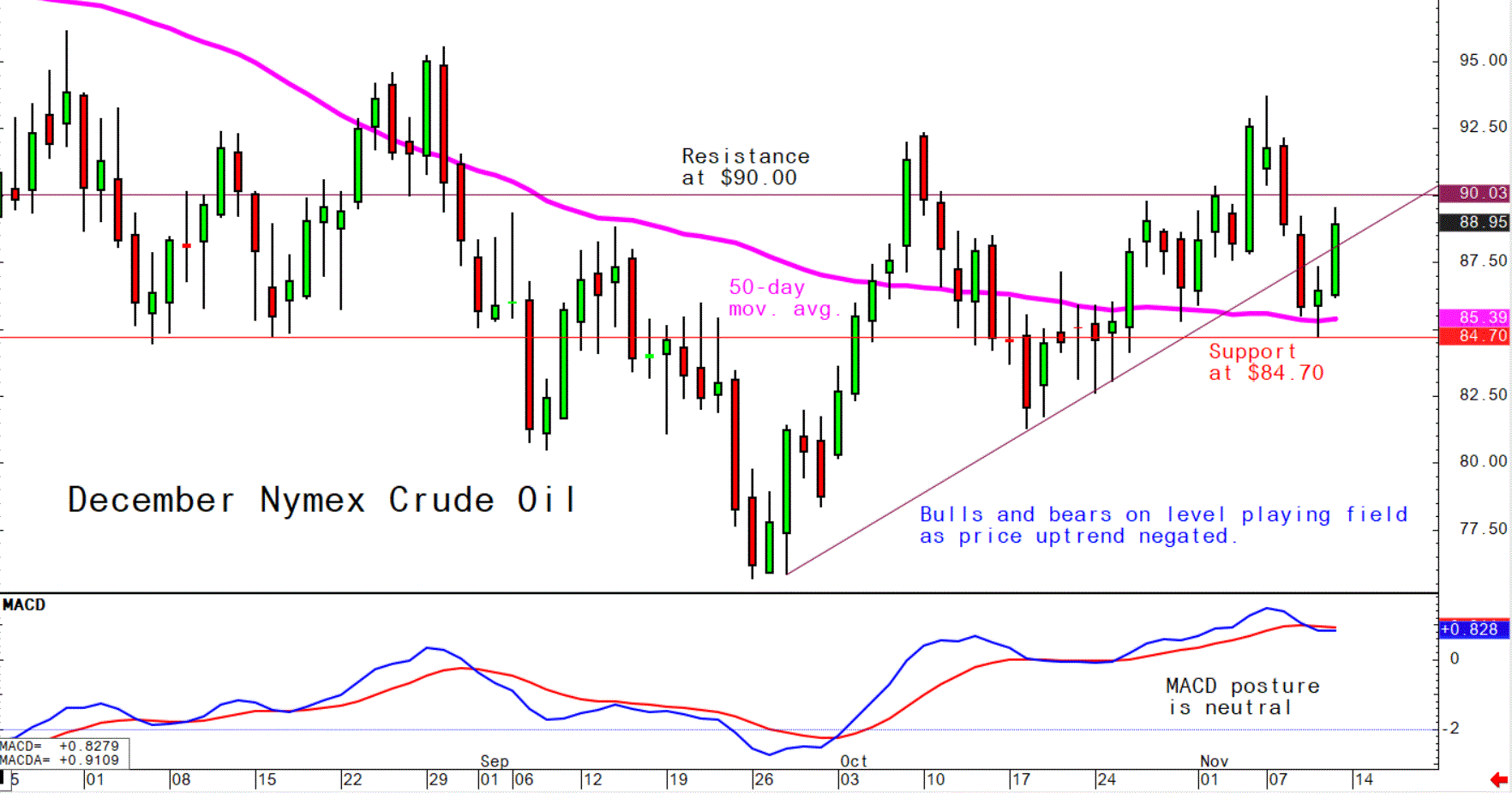
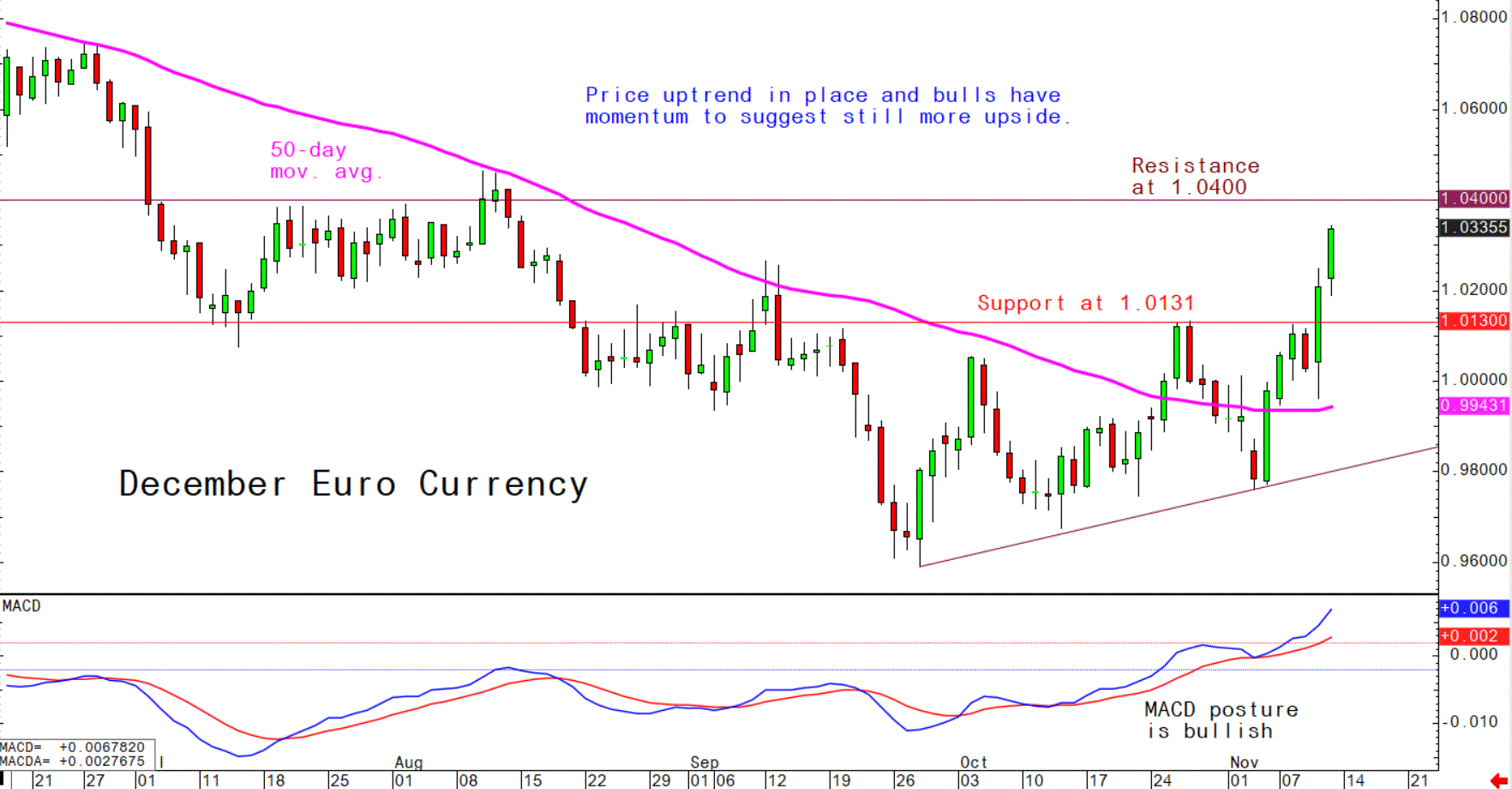
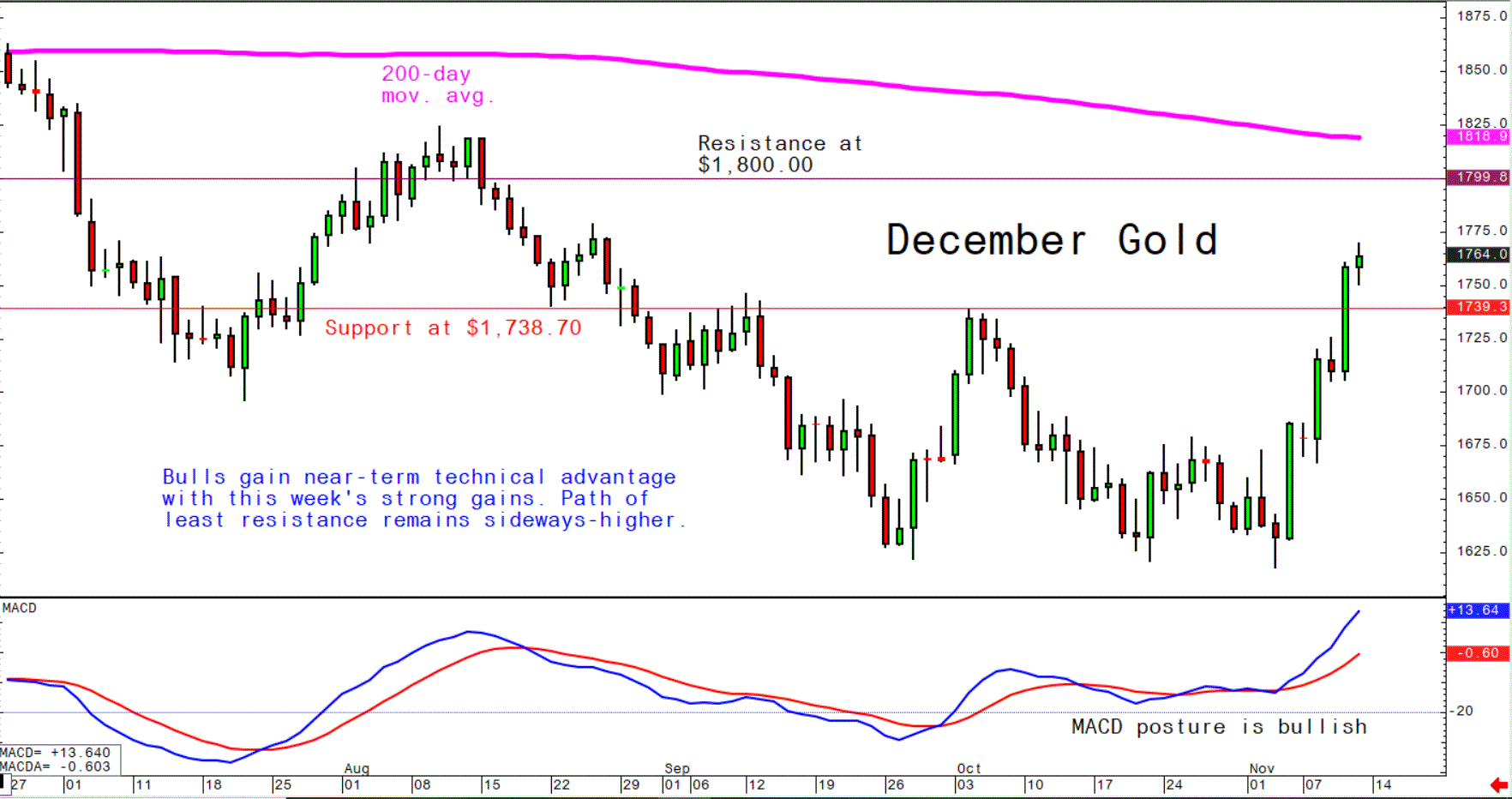
On tap today:
• University of Michigan's consumer sentiment index, due at 10 a.m. ET, is expected to fall to 59.5 in the opening weeks of November from a final reading of 59.9 in October.
• Baker Hughes rig count is out at 1 p.m. ET.
Mortgage rates rose back above 7% this week, matching their highest level in 20 years. The rapid climb in mortgage costs this year has pushed home buyers out of the market and forced many sellers to decide between lowering prices or taking their homes off the market.
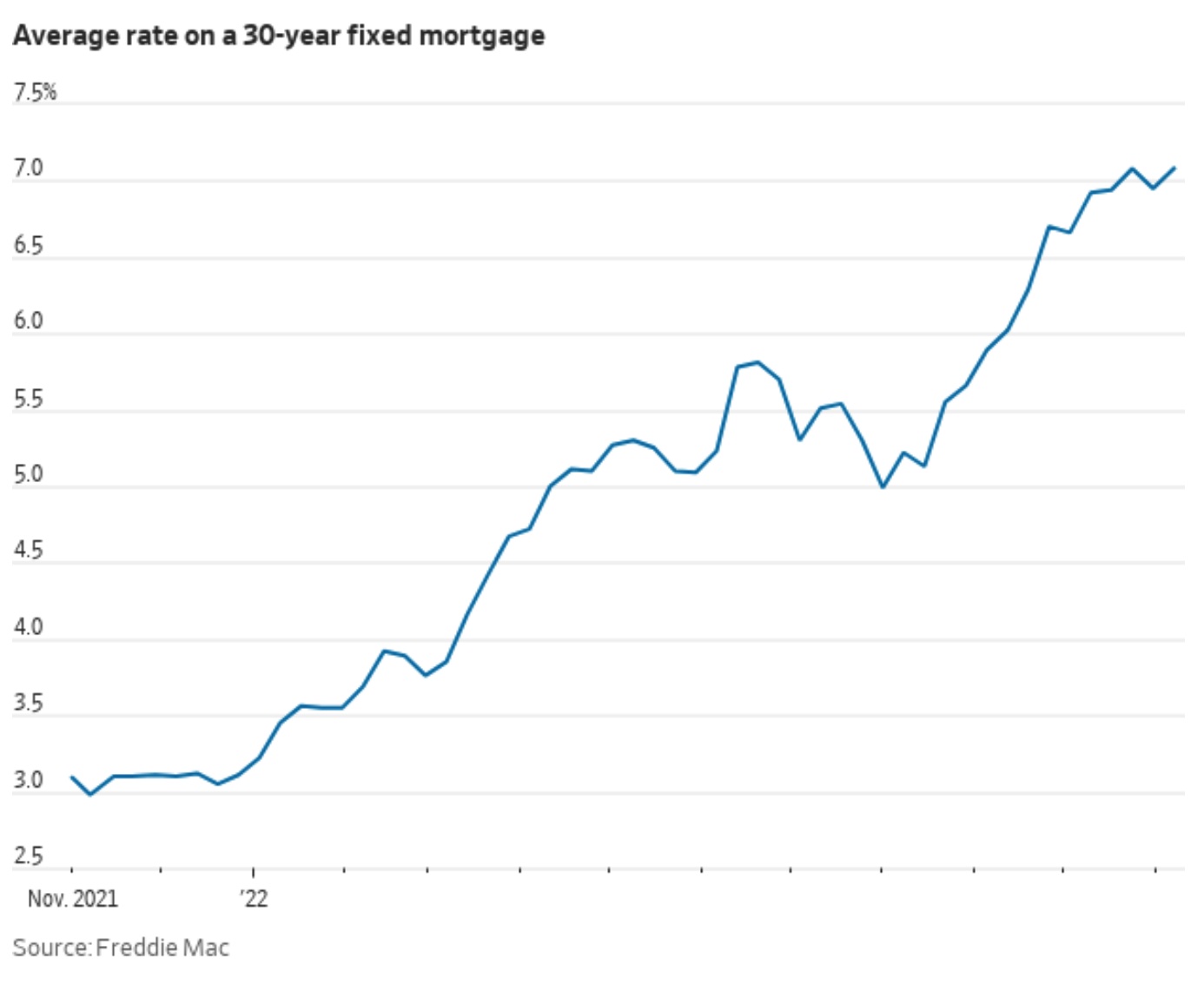
Yellen doesn’t know if lower U.S. inflation data is turning point. Treasury Secretary Janet Yellen told Reuters it was good to see the latest U.S. consumer inflation data suggest upward pressures are easing, but she doesn’t know if it was “a turning point.” She added, “I never make more of one data point. That is one data point. It was certainly nice to see an inflation report that came in on the low side of expectations rather than the high side and, you know, we’ve seen early indications along the pipeline that inflation might be diminishing.”
EU revises GDP, inflation forecasts. The eurozone economy will grow more than previously expected in 2022, the European Commission forecast on Friday, and decelerate more than previously thought in 2023. The commission forecasts the eurozone economy will grow 3.2% this year, up from its 2.7% projection in July, but then slow down sharply to 0.3% growth next year, well below the July forecast of 1.4%, before rebounding 1.5% in 2024. Eurozone inflation is expected to decelerate from 8.5% this year to 6.1% in 2023 and ease to 2.6% in 2024.
Market perspectives:
• U.S. inflation eased in October to the slowest pace since January. The Labor Department on Thursday said that its consumer-price index increased 7.7% in October from the same month a year ago, down from 8.2% in September and June’s 9.1% rate, which was the highest in four decades. The so-called core CP I— which excludes volatile energy and food prices — climbed 6.3% in October from a year earlier, down from 6.6% in September, which was the biggest increase since August 1982

• WTI crude futures surged more than 3% to above the $89 per barrel mark as news of China relaxing some of its stringent coronavirus-induced restrictions lifted the outlook for demand. Meanwhile, prospects for global oil markets would remain extremely tight continued to lend optimism to bulls. OPEC+ has recently agreed to cut production by 2 million barrels per day in November. Keeping a lid on prices were persistent concerns about a potential recession-driven demand downturn triggered by an aggressive tightening from major central banks. The U.S. benchmark fell almost 4% this week, putting it on track for its first weekly decline in four.
• Ag trade: South Korea purchased 69,000 MT of optional origin corn and passed on another tender to buy up to 68,000 MT of optional origin corn. Japan purchased 94,603 MT of wheat in its weekly tender, including 62,423 MT of U.S. and 32,180 MT Canadian. Indonesia purchased 60,000 MT of U.S. milling wheat and 60,000 MT of Canadian milling wheat. The Philippines passed on a tender to buy 60,000 MT of feed wheat.
• NWS weather: Tropical Depression Nicole will continue to weaken and become post-tropical on Friday as it interacts with approaching cold front... ...Heavy rainfall and severe thunderstorms possible across Eastern region as Nicole undergoes extratropical transition... ...Below-average temperatures will impact much of the lower 48 by end of weekend...
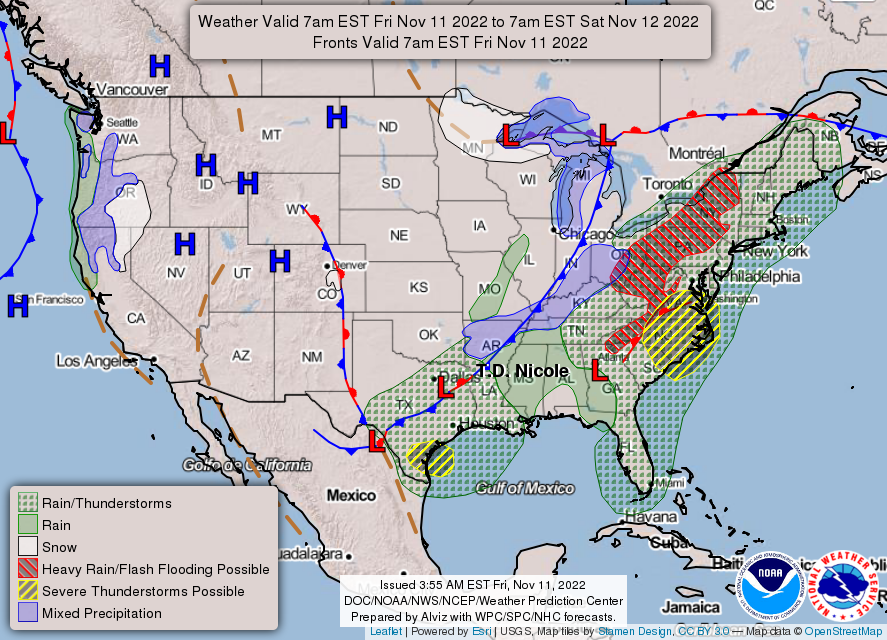
Items in Pro Farmer's First Thing Today include:
• Big price rebound overnight
• Russia lowers wheat export tax
• Indonesia raises palm reference price, export tax
• China to auction more soybeans
• Not much cash cattle activity
• Cash hog fundamentals weaken
|
RUSSIA/UKRAINE |
— Summary: Russia’s defense ministry said it had completed a full withdrawal of troops from the western bank of the Dnieper River in Kherson province. Ukrainian forces said they made big advances towards Kherson city on Friday as Russian troops retreated, and a Ukrainian flag was raised in the regional capital. The Antonivskiy bridge, a crucial route connecting Kherson city to the new Russian defensive line, collapsed. More than 100,000 troops from Russia and Ukraine each have been killed or wounded, the top U.S. general said.
- Kremlin: Work underway to address Russia’s concerns on grain deal. “Negotiations and contacts are continuing,” Kremlin spokesman Dmitry Peskov said, as officials from Russia and the United Nations met in Geneva to discuss a possible extension of the deal. “It is necessary to resolve a number of issues related to a well-known part of the so-called grain deal that concern us. Here there is mutual understanding on the part of our counterparts in the United Nations, so work is underway,” he said. Russia’s agricultural exports have not been directly targeted by Western sanctions, but Moscow says blocks on Russia’s payments, logistics and insurance industries were a “barrier” to Russia being able to export its grain and fertilizer.
- U.S. downgrades Russia to nonmarket economy. The Commerce Department said Thursday it has reclassified Russia as a nonmarket country from a market economy, a move aimed at further reducing bilateral trade and isolating Russia amid its continued war in Ukraine.
|
POLICY UPDATE |
— Federal judge in Texas strikes down Biden’s student loan forgiveness plan. The Job Creators Network Foundation filed a lawsuit in October on behalf of a borrower who does not qualify for the full $20,000 in debt relief and one who is ineligible altogether. The suit alleges the administration violated federal procedures by denying borrowers the opportunity to provide public comment before unveiling the program. U.S. District Judge Mark T. Pittman, who was appointed by Donald Trump, declared the policy unlawful in the Thursday order. “In this country, we are not ruled by an all-powerful executive with a pen and a phone,” Pittman wrote in his order. “Instead, we are ruled by a Constitution that provides for three distinct and independent branches of government.” In a statement, White House press secretary Karine Jean-Pierre said the administration said: “We strongly disagree with the District Court’s ruling on our student debt relief program and the Department of Justice has filed an appeal.”
More than 26 million people have applied for loan relief. Jean-Pierre said the administration will hold onto their information “so it can quickly process their relief once we prevail in court.”
|
CHINA UPDATE |
— China loosened aspects of its punishing zero-Covid policy on Friday, shortening quarantine periods and abandoning its effort to track secondary contacts. Asian stock markets, already excited about the American inflation figures, rose. Meanwhile, Chinese authorities counted more than 10,000 new infections (most of them asymptomatic), more than at any point since April. Guangzhou and some other cities remain locked down.

— President Biden and Chinese leader Xi Jinping will meet in person as presidents of the U.S. and China for the first time on Monday, ahead of the G20 summit in Bali. The two leaders are at loggerheads over a range of issues, including Taiwan, human rights and trade. Russia’s president, Vladimir Putin, does not plan to attend the summit.
|
ENERGY & CLIMATE CHANGE |
— COP 27 update. Scientists presented findings at the U.N.’s COP27 summit in Egypt that showed the Earth to be on course to breach the 1.5-degree limit — set in Paris in 2015 — in only nine years. Global carbon emissions increased by 1% this year, even during an energy crisis. Meanwhile, the heads of several African governments said that they must be allowed to use fossil fuels to lift their countries out of poverty.
— President Biden is heading to a U.N. summit today where he is expected to tout his climate record. In a speech to the COP27 summit in Egypt, Biden will proclaim the U.S. is back as a global leader on climate change following passage of the Inflation Reduction Act, which included around $370 billion in clean energy incentives meant to slash the use of harmful greenhouse gases.
— WSJ: Biden to announce restrictions on methane emissions at COP27. President Biden is set to announce tighter restrictions on methane emissions and more funding for developing countries to adapt to the effects of climate change, the Wall Street Journal reports (link).
|
POLITICS & ELECTIONS |
— Cook Political Report (CPR) issues a clarification: “The CPR does not call races as part of our work, and the CPR has not called the AZ race. We await the AP call along with you.” This follows a report from Punchbowl News that Dave Wasserman of the Cook Political Report with Amy Walter called the race in Arizona for Sen. Mark Kelly (D-Ariz.) over Blake Masters. The Associated Press has not called this race. The Arizona race has thousands of mailed or hand-delivered ballots on Election Day to be counted and some of those will be tilted toward Masters. Still others note that Democrats’ path to keeping control of the Senate became clearer. Mail ballots broke their way in Nevada and Arizona. Nevada election officials plan to count through the weekend.
Wasserman this morning in the CPR newsletter wrote: “More than 48 hours since polls closed, Republicans maintain a clear edge in the race for 218 seats and House control — but it's still not assured, and even if they do flip the chamber, it could be by a razor-thin margin. According to our 2022 House vote tracker, Republicans have captured 211 seats and Democrats have secured 200 seats. There are 24 seats where no network has ‘called’ a winner that remain uncertain… Of the 24 unresolved races, we see Democrats as the favorites in ten, Republicans as the favorites in eight and six too close to call. That means Democrats would need to sweep the "no favorite" races and nab at least one of the Republican-favored races to hold the majority — a tall order. If the unclear races were to break evenly, Republicans would win a 222-213 edge, a mirror image of Democrats' current margin in the House.”
Election officials say it may take days to count the more than 500,000 votes remaining in Arizona and about 95,000 others in Nevada. Many U.S. voters from other states wonder why Arizona and Nevada can’t be like Florida in dealing with far more voters. The AP reports that in the Nevada Senate and Gubernatorial contests, “Clark County, with 1.3 million registered voters, is the only county in Nevada that leans Democratic. It has more than 50,000 outstanding ballots,” Registrar Joe Gloria “said Thursday, but he refused to give a breakdown of how many were received in ballot drop-boxes compared with those received in the mail. That distinction is important to campaigns as they assess whether their candidates can expect to make up ground. In the second-most populous county, Washoe, at least 40,000 ballots remain to be counted.” Results posted on the website of the Las Vegas Review-Journal at midnight showed challenger Adam Laxalt (R) leading Sen. Catherine Cortez Masto 48.9% to 48.0%, a difference of about 8,000 votes. In the gubernatorial contest, Joe Lombard (R) leads Gov. Steve Sisolak (D) 49.6% to 46.6%, a difference of about 27,000 votes.
The AP reports Democrats “padded their narrow leads in key Arizona contests on Thursday. Sen. Mark Kelly (D) led Blake Masters (R) by 5.6 percentage points, while Democrat Katie Hobbs had a much tighter lead of 1.4 points against Republican Kari Lake in the governor’s race. Democrats also led in the races for secretary of state and attorney general. Election officials in Maricopa County, which includes metro Phoenix and more than 60% of voters, are expected to begin reporting results Friday from a crucial group of ballots — nearly 300,000 mail ballots that were returned on Election Day. That group has swung wildly in recent election cycles, from strongly Democratic in the 2018 midterms to strongly Republican in 2020.” As of Thursday afternoon, 619,000 ballots remain uncounted, according to the Arizona secretary of state’s office.
— House control remains uncertain but most signal a very modest GOP takeover of the chamber. Republicans appear to be slowly inching toward the 218 seats that would deliver them a narrow victory, but incoming results from California and Colorado could ultimately determine which party controls the chamber.
— Tina Kotek, a progressive Democrat, won the Oregon governor’s race. She’s the second openly lesbian candidate for governor to win this week. Republicans failed in their bid for the first GOP governor of the state in 40 years.
— Donald Trump bristled at Ron DeSantis’s resounding re-election this week as Florida’s governor. The former president dismissed his one-time ally as a “lightweight,” adding that DeSantis had been in “desperate shape” during his first campaign in 2017 — until Trump deigned to turn it around with a magnanimous single-hand. A fierce rivalry is emerging for the Republicans’ 2024 presidential nomination while “Trump fatigue” has definitely set in among a growing number of prior Trump supporters.
|
OTHER ITEMS OF NOTE |
— Cotton AWP moves higher. The Adjusted World Price for cotton rose to 76.74 cents per pound, effective today (Nov. 11), up from 65.46 cents per pound the prior week. This ended three straight weekly declines in the AWP. However, it remains well below the level it struck in May of 147.10 cents per pound the week of May 6. Meanwhile, USDA resumed the establishment of an upland cotton import quota, announcing that Special Import Quota #4 would be established Nov. 17 for the import of 46,370 bales of upland cotton, applying to cotton purchased not later than Feb. 14 and entered into the U.S. not later than May 15. USDA must announce a special import quota if the U.S. Far East price exceeds the prevailing world market price for a consecutive four-week period.
— Elon Musk told Twitter employees that the company didn’t have the necessary cash to survive. The social media company was running a negative cash flow of several billion dollars, Musk added, without specifying if that was an annual figure. He mentioned bankruptcy.
|
KEY LINKS |
WASDE | Crop Production | USDA weekly reports | Crop Progress | Food prices | Farm income | Export Sales weekly | ERP dashboard | California phase-out of gas-powered vehicles | RFS | IRA: Biofuels | IRA: Ag | Student loan forgiveness | Russia/Ukraine war, lessons learned | Election predictions: Split-ticket | Congress to-do list | SCOTUS on WOTUS | SCOTUS on Prop 12 | New farm bill primer | China outlook |

